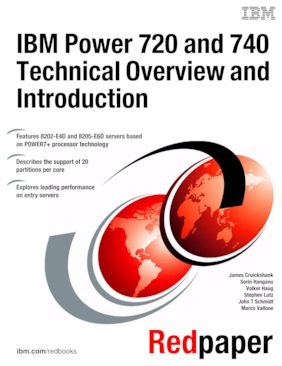About cookies on this site Our websites require some cookies to function properly (required). In addition, other cookies may be used with your consent to analyze site usage, improve the user experience and for advertising. For more information, please review your options. By visiting our website, you agree to our processing of information as described in IBM’sprivacy statement. To provide a smooth navigation, your cookie preferences will be shared across the IBM web domains listed here.

Published on 16 May 2013
Read in Google Books
Share this page:
ISBN-10: 0738451231
ISBN-13: 9780738451237
IBM Form #: REDP-4984-00
Authors: Scott Vetter, James Cruickshank, Sorin Hanganu, Volker Haug, Stephen Lutz, John T Schmidt and Marco Vallone
Abstract
This IBM® Redpaper™ publication is a comprehensive guide covering the IBM Power 720 and Power 740 servers that support IBM AIX®, IBM i, and Linux operating systems. The goal of this paper is to introduce the innovative Power 720 and Power 740 offerings and their major functions:
- The IBM POWER7+™ processor is available at frequencies of 3.6 GHz, and 4.2 GHz.
- The larger IBM POWER7+ Level 3 cache provides greater bandwidth, capacity, and reliability.
- The 4-port 10/100/1000 Base-TX Ethernet PCI Express adapter is included in base configuration and installed in a PCIe Gen2 x4 slot.
- The integrated SAS/SATA controller for HDD, SSD, tape, and DVD supports built-in hardware RAID 0, 1, and 10.
- New IBM PowerVM® V2.2.2 features, such as 20 LPARs per core.
- The improved IBM Active Memory™ Expansion technology provides more usable memory than is physically installed in the system.
- High-performance SSD drawer.
Professionals who want to acquire a better understanding of IBM Power Systems™ products can benefit from reading this paper.
This paper expands the current set of IBM Power Systems documentation by providing a desktop reference that offers a detailed technical description of the Power 720 and Power 740 systems.
This paper does not replace the latest marketing materials and configuration tools. It is intended as an additional source of information that, together with existing sources, can be used to enhance your knowledge of IBM server solutions.
Table of Contents
Chapter 1. General description
Chapter 2. Architecture and technical overview
Chapter 3. Virtualization
Chapter 4. Continuous availability and manageability